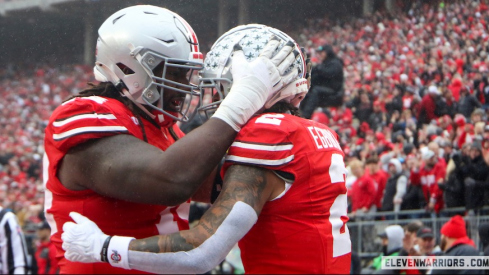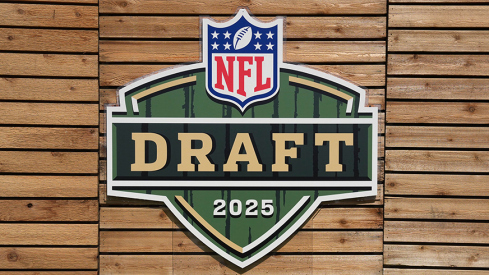
Q. Coach, is it a compliment to say it's a bend but don't break defense, and if not, why is it not okay to give up 500 yards zero points?
COACH MEYER: I think that's a very good question, because at the end of the day your job is to go win a game. I'm not comfortable we have a plan to win around here. You see the field position chart. We make a big deal once we pin them in, get them in there, give us the ball back and let's go. That's not happening.
We have a lot of punts saved where we're getting the ball back on the 12-yard line. That's because we give up some yards, give up some runs but we're not giving up the home run yards.
So, I am not personally—that's not how I want Ohio State defense to be played for our careers. However, I do understand injury issues. I do understand when a team comes rolling in here with good athletes at receiver and they're not going to be systematically beat Ohio State. So there's a lot of reasons. But your question is I think that's a question of a lot of people. A lot of coaches have that same discussion.
And at the end of the day keep them out of the end zone. That's where we're at right now.
Urban Meyer's somewhat fatalistic answer belies the state of the Ohio State defense. The Buckeye defense has a sizeable hole in the middle at linebacker. Yet this is only part of the story. Schematically, the defensive coaching staff seemingly lacks a unifying theme as to what type of defense they want to be. The result is a muddle-through approach that is producing systematic breakdowns. The Buckeye staff needs to settle upon how they want to philosophically approach defense moving forward. Only then can the defense adjust at the application stage to limit personnel shortcomings.
Coverage Confusion
Nowhere is this conflicting approach more apparent than in the defensive backfield. UAB stumbled into exploiting Ohio State with wide receiver screens simply because OSU could not stop the football. By my count, UAB threw 14 WR or slip screens. The Blazers were particularly effective with flash screens, running the play six times for approximately eight yards per play. UAB was so effective mainly because of Ohio State's alignment below:

Christian Bryant is coming up into the underneath curl zone, but the corners are giving so much cushion that it is an easy pitch and catch.
The easy answer is to align the corners in press coverage. But the larger issue is that OSU seems schematically confused as to whom it wants to be. It is far easier to adjust when you are working from one basic premise. Everett Withers is known for running cover 4. Yet the past two weeks OSU has shown far more cover 3. This suggests some indecision amongst the coaches as to what this defense should be and what its players can do. OSU has run both coverages in past years, and numerous defenses cycle between coverages. But a team needs an overall framework to work from and build upon. OSU's problem is that they seem stuck cycling through ideas without having a 'theory of the case.' The result is a pale imitation of what these coverages should be. Take cover 4 for example. Cover 4 is a matchup zone that often results in man coverage based upon pattern distribution and allows the two safeties to become force players in the run game.

It is not difficult to see that cover 4 is weakest in the underneath flats. But cover 4 is adaptable. For instance, a 'Meg' call can be made that puts the corner in man coverage, allowing him to aggressively take away the flat. Cover 4 also needs to adapt to three receivers to one side, aka trips. The coverage does so with a 'banjo' call, where the outside linebacker takes the first outside route, and the inside linebacker takes the second inside route. Yet here is Ohio State in cover 4 against UAB. The cover 4 is exceedingly soft and OSU does not run banjo, leaving it exposed to No. 3 catching an easy bubble screen for a first down.
This adaptability is true of cover 3 and all other coverages. Cover 3 has been used for years to play 8-man coverage with the strong safety in aggressive run support and Nick Saban's defenses pattern matches from cover 3. Indeed, it is not difficult to roll your corners up and then having them drop to their deep third at the snap. The point is that any coverage is adaptable in this manner. As Meyer stated, extensive man coverage may not be ideal for this team because it leaves linebackers in man coverage.
The problem is when you stress corners means linebacker has to play man coverage on someone. That's what we did a couple times against Cal. And that was a problem. So make the corners play man but there's three other receivers somewhere you have to cover as well.
But the choice is not binary—soft zone or press man. Zone coverages are also adaptable. But the Ohio State coaches seemingly cannot determine how they want to deploy their defense or what they believe their back seven is capable of playing. This may be resulting because ultimately the Ohio State coaching staff does not know who they want to be as a defense. A team needs to answer this prima facie question before it can start implementing a game plan. The result is that the Buckeye defense is taking the lowest common denominator in keeping things as basic and conservative as possible, to the detriment of allowing yards.
A hole in the middle
The problem that may be causing the Ohio State's coaching staff this confusion is inconsistent linebacker play. The OSU linebackers often do not demonstrate an instinctual feel for the position. This leads to a slowness to react that puts them out of position. The linebackers do not attack downhill against run plays, and are slow to react laterally and then over pursue the football. For instance, in the clip below, OSU's linebackers are slow to react and then backpedal against clear inverted veer run action. While the play is supposed to constrain the defense as to whom is to carry the ball, it is not supposed to cause a defense's linebackers to think 'pass' as it does here. The result is that the Buckeye linebackers are not even taking on blocks until five yards downfield.
As such, the Ohio State defensive line either makes a play at the line of scrimmage, or opposing offenses get yards in space. This weakness is thus somewhat concealing the phenomenal play of Johnathan Hankins, who is ranging sideline-to-sideline to record double digit tackles. He steps up his game with each half. By the end against UAB, he was literally tracking down running backs on outside plays. The defensive line is fulfilling its responsibilities, but cannot go beyond its role and the Buckeye second level is not cleaning up the remaining plays.
Limiting the Holes
Ohio State cannot change its linebackers other than working with them to improve. And improvement can be expected. It is easy to forget that Ryan Shazier is starting his first full season. Like other young players for Ohio State, he has growing pains despite all the talent. Currently he is making plays on his great athleticism and will only continue to get technically better. Yet OSU, building on the earlier theme, can also take schematic steps to reduce its deficiency. One is increasing safety support. Christian Bryant is quickly becoming an impact defensive player and one of the defense's surer tacklers. The OSU coaches recognize this, increasingly bringing him into the box. OSU needs to put Bryant in a position with its coverages where he can provide support within ten yards and not be backpedaling at the snap.
To take this one step further, OSU's 'linebacker' weakness is not limited to the linebackers, but also extends to the star position. OSU spends a majority of plays in nickel. The star, responsible for force in the field flat, is one of the most important positions. Yet OSU is not getting the stellar star play it is used to, which is particularly noticeable against screens. Ohio State depth is so limited defensively that it needs to get its best players on the field. It is not in a position to keep talent on the sideline.
To that end, a bright spot for the Buckeyes against UAB was Doran Grant's play in his first start. Grant is not only stellar in coverage but also proved himself to be a sure tackler—something this defense is lacking. Grant is simply too good to not play. Unconventionally, then, OSU should consider using Grant in its nickel coverage at safety, moving Bryant to star. This would put someone at star that can play the position with the requisite physicality, while also bringing in a third defensive back who can play man coverage while also provide tackling support. The OSU defense is at the point that it simply needs to get playmakers on the field and needs to mix things up to do so.
Michigan State and Beyond
As Meyer stated in the initial quote, this defense must crawl before it can walk. So the defense tightening and not allowing a touchdown was a positive step. The defense cannot be the dominant unit that Ohio State fans have become accustomed to until they get better linebacker play. But the Buckeyes do have some playmakers on defense, and will be helped by the return of Bradley Roby and C.J. Barnett. The Buckeye coaching staff can improve the situation by 1) settling on a unified philosophy and 2) making sure that those playmakers are put in a position to make plays by trusting its defensive backs and allowing its safeties to be active in the run game. This does not have to mean man coverage every play, but it does mean playing the zone coverages as they are intended to be played, not as soft imitations.
By thinking outside the box such as putting Grant in with nickel, suddenly OSU could have a solid back five. Michigan State has obviously seen these weaknesses and will attempt to exploit it with Le'Veon Bell. Ohio State must be prepared to first and foremost focus upon limiting Bell, or Michigan State will eat up chunks of clock, control time of possession, and be difficult to stop.

